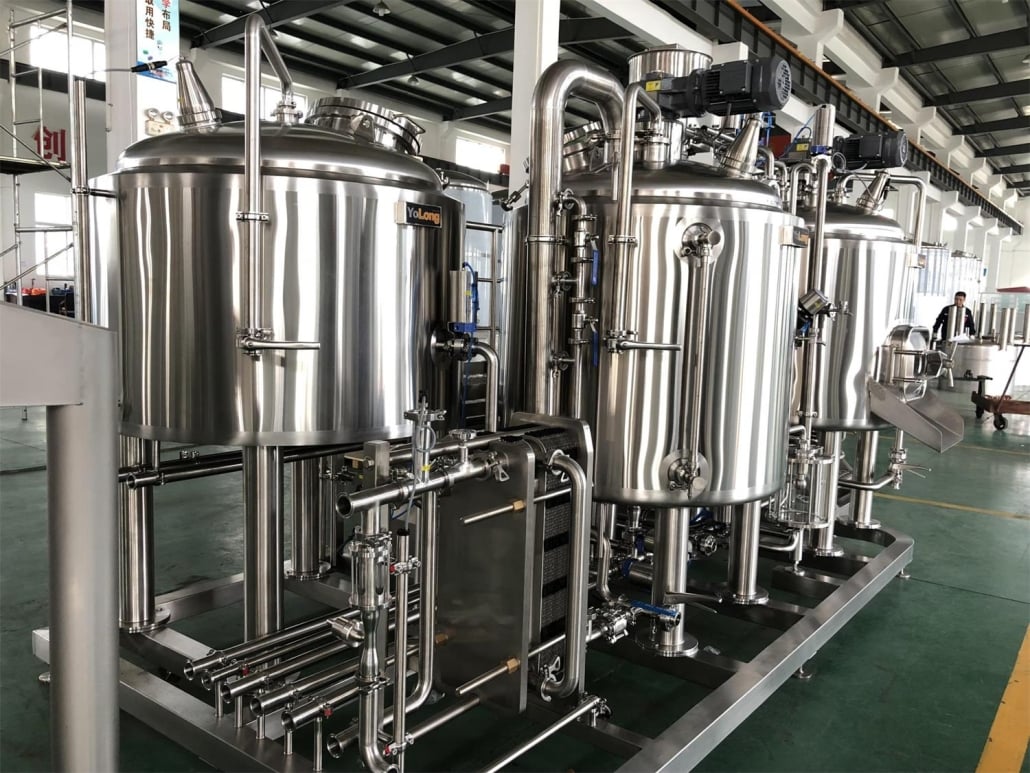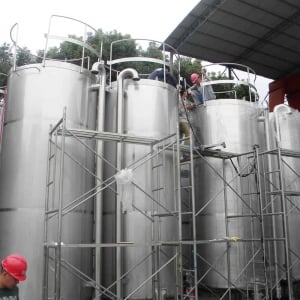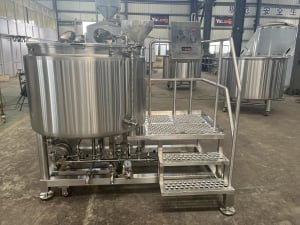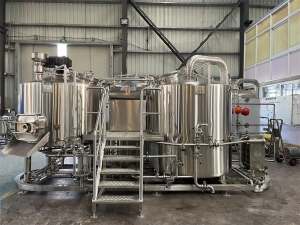Table of Contents
ToggleWhat is a 3 Vessel Brewhouse?
A 3 vessel brewhouse is an integral part of the brewing process. It is a brewing setup that consists of three primary vessels: the mash tun, the lauter tun, and the boil kettle. These three vessels are used in sequence to transform malted barley and water into wort, the sugary liquid that will eventually be fermented into beer.
The mash tun is the initial vessel where the milled grains are mixed with hot water, allowing the enzymes to break down the starches into fermentable sugars. This process, known as mashing, typically lasts about an hour and results in a thick, porridge-like mixture.
The liquid is then transferred to the lauter tun, where it’s separated from the grain husks. The liquid, now called wort, is drained from the bottom, while the remaining grains are left behind.
The wort is then moved to the boil kettle. Here, hops and other ingredients are added, and the mixture is boiled for a specified amount of time. This step not only extracts flavors and bitterness from the hops but also sterilizes the wort.
After boiling, the wort is cooled and moved to fermentation tanks, where yeast is added, and the transformation to beer begins.
In the brewing world, efficiency is key. A 3 vessel brewhouse provides brewers with greater control over each phase of the brewing process, ensuring consistent quality and flavor profiles for each batch of beer.
For those who are passionate about beer and are considering diving into the craft brewing industry, understanding the equipment, like the 3 vessel brewhouse, is essential.
How Much Does a 3 Vessel Brewhouse Cost?
When diving into the world of brewing, the cost of equipment is a significant factor to consider. Among the essential pieces of equipment is the 3 vessel brewhouse. The price of a 3 vessel brewhouse can vary significantly based on size, brand, features, and the material of construction. Here’s a breakdown of the costs associated with purchasing a 3 vessel brewhouse.
It’s crucial first to determine the size of the brewhouse you require. Brewhouses can range from small 1-barrel systems suitable for nano-breweries or experimental batches to large 100-barrel systems used by regional craft breweries. The size will considerably influence the price.
Brand reputation also plays a significant role in determining the cost. Premium brands, known for their durability and advanced features, often command higher prices than lesser-known brands.
Materials, especially the grade of stainless steel used, can also influence price. Higher grade materials that are more corrosion-resistant and durable will come at a premium.
Here’s a rough estimate of the cost range for various sizes:
| Size (Barrels) | Estimated Cost Range |
|---|---|
| 1 | $20,000 – $40,000 |
| 3 | $50,000 – $90,000 |
| 7 | $80,000 – $150,000 |
| 15 | $120,000 – $250,000 |
| 30 | $200,000 – $400,000 |
| 50+ | $300,000 and up |
Another key factor is customization. Some breweries have specific requirements and might need modifications or additional features in their brewhouse, which can increase the cost. This might include advanced automation, specialized fittings, or unique design elements tailored to the brewery’s operations.
Furthermore, it’s essential to factor in other costs associated with setting up a 3 vessel brewhouse. This includes installation costs, which can vary based on the complexity of the system and any required infrastructure modifications. Also, shipping or delivery fees, especially for larger systems or international purchases, can add a substantial amount to the overall cost.
When purchasing a 3 vessel brewhouse, it’s recommended to request quotes from multiple manufacturers and suppliers. This will not only give you a better sense of the market rate but also allow you to gauge the value of the features and services each company offers. Always remember to consider the brand’s reputation, reviews from other brewers, and warranty terms before making a final decision.
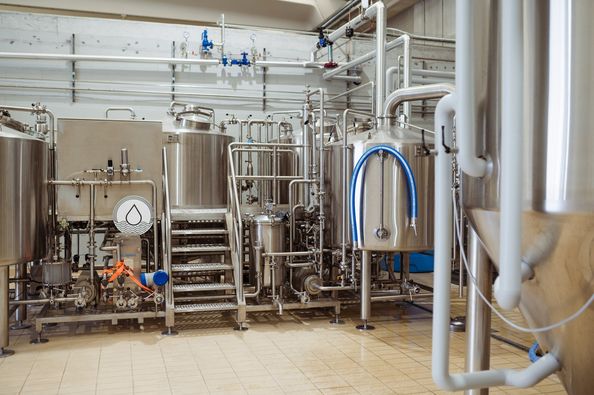
What are the Types of 3 Vessel Brewhouse?
When it comes to brewing beer, the 3 vessel brewhouse system stands out as a popular choice among many brewers. However, under this umbrella, there are several different configurations and types that cater to various brewing needs. The choice largely depends on the brewer’s preferences, the specific requirements of their beer recipes, and the scale of production.
- Direct Fire System: This system uses a burner to apply direct heat to the vessel. It’s often preferred for its quick heating capabilities and can be found in smaller-scale operations due to its cost-effectiveness. Price Range: $25,000 – $70,000.
- Steam Heating System: Using steam as a heat source, this system provides even heating and prevents the risk of scorching the wort. It’s a favorite for larger-scale operations where consistency and precision are key. Price Range: $40,000 – $150,000.
- Electric Heating System: This system uses electric elements to heat the wort. It offers precise temperature control and is popular for indoor brewing operations where open flames or steam might not be feasible. Price Range: $30,000 – $80,000.
- Hybrid Systems: As the name suggests, these systems combine features from the above types. For instance, a brewhouse might use electric heating for the mash tun and direct fire for the boil kettle. These systems allow for a greater level of customization based on the brewer’s specific needs. Price Range: $35,000 – $100,000.
When considering a 3 vessel brewhouse, it’s crucial to assess the benefits and drawbacks of each type. Factors such as energy costs, efficiency, precision, and installation requirements will play a significant role in the decision-making process.
Functions of a 3 Vessel Brewhouse
A 3 vessel brewhouse is at the heart of any brewing operation. Its primary purpose is to facilitate the transformation of grains, water, hops, and other ingredients into beer. Let’s delve deeper into the specific functions of each of the three vessels.
- Mash Tun: The mash tun is where the brewing process begins. Here, milled grains, commonly referred to as grist, are mixed with heated water. This process, known as mashing, activates enzymes in the malt which convert starches into fermentable sugars. The consistency at this stage resembles a porridge. The temperature and duration of the mashing process can vary based on the beer style and recipe.
- Lauter Tun: After mashing, the resulting liquid, known as wort, needs to be separated from the solid grain husks. The lauter tun accomplishes this task. It’s equipped with slotted plates or a slotted false bottom that allows the wort to be drawn off from the grains. Sparging, the process of rinsing the grains with water to extract any remaining sugars, also takes place in this vessel.
- Boil Kettle: Once the wort is separated from the grains, it’s transferred to the boil kettle. In this vessel, the wort is boiled, typically for 60-90 minutes, and hops are added at various intervals. Boiling serves multiple purposes: it sterilizes the wort, extracts flavors and bitterness from the hops, and evaporates unwanted volatile compounds.
While these are the primary functions of each vessel, many modern 3 vessel brewhouses come equipped with advanced features like temperature controls, automated stirring mechanisms, and grain rakes. These additions aid in consistency, efficiency, and the overall quality of the brewing process.
Applications of a 3 Vessel Brewhouse
In the vast landscape of brewing, the 3 vessel brewhouse stands out as an adaptable and versatile system. Its application goes beyond just producing beer for consumption. Let’s explore the wide-ranging applications of a 3 vessel brewhouse system.
- Craft Breweries: Arguably the most common application, craft breweries use 3 vessel brewhouse systems to produce a wide variety of beer styles. From stouts to IPAs, this setup provides the flexibility and control needed for artisanal beer production.
- Pilot Batches: Before scaling up a new beer recipe for mass production, breweries often test small batches. A smaller 3 vessel brewhouse is perfect for this, enabling brewers to tweak and perfect their recipes.
- Educational Institutions: Many universities and technical schools with brewing science programs use 3 vessel brewhouses as teaching tools. These systems provide hands-on experience, allowing students to learn the practical aspects of brewing.
- Brewpubs: These are restaurants that brew their beer on-site. A 3 vessel brewhouse is ideal for brewpubs due to its efficiency and compactness. It allows for a fresh and varied beer menu, enhancing the dining experience.
- Research and Development: For breweries looking to innovate or expand their product line, a dedicated R&D brewhouse is crucial. The 3 vessel system, especially in smaller scales, is perfect for experimenting with new ingredients, brewing techniques, or beer styles.
| Application | Size (Barrels) | Notes |
|---|---|---|
| Craft Breweries | 10-100 | Used for mainstream beer production. |
| Pilot Batches | 1-3 | Small batches for testing recipes. |
| Educational Purposes | 1-10 | Used in universities and brewing schools. |
| Brewpubs | 3-15 | On-site brewing for restaurants. |
| R&D | 1-7 | Dedicated system for experimentation and innovation. |
- Collaborative Brewing: Many breweries collaborate to produce special edition beers. A 3 vessel brewhouse can be used to brew these unique batches, allowing brewers from different backgrounds to merge their expertise.
- Festivals and Competitions: Many beer festivals and competitions require fresh brews made specifically for the event. A 3 vessel brewhouse can be employed to craft these special batches, ensuring peak flavor and freshness.
- Specialty Brews: Beyond traditional beers, a 3 vessel brewhouse can also be used to produce specialty beverages like gluten-free beers, non-alcoholic brews, and even beverages that incorporate unconventional ingredients like fruits, spices, or herbs.
With its multifaceted applications, the 3 vessel brewhouse remains a cornerstone in the brewing industry, catering to a plethora of brewing needs and ambitions. Whether for large-scale production or niche brewing projects, this system proves invaluable.
How Does a 3 Vessel Brewhouse Benefit You?
A 3 vessel brewhouse has emerged as a favorite among many brewers, from novices to professionals. But why? It’s not just about having three vessels; it’s about what those vessels can achieve together in the brewing process. Here are the key benefits:
- Efficiency: Having dedicated vessels for mashing, lautering, and boiling means that each stage of the brewing process can be optimized. This specialization ensures that processes run smoothly without the need to reset or reconfigure equipment between stages.
- Consistency: One of the challenges in brewing is achieving consistency across batches. With separate vessels, temperature control is more precise, ensuring that every batch of beer tastes as it should. This consistency is crucial, especially for commercial breweries where brand reputation is on the line.
- Flexibility: The 3 vessel system offers flexibility in brewing. Whether you want to experiment with extended mashing times, varying lautering techniques, or unique boil additions, having separate vessels makes these variations easier to manage.
- Increased Production: One of the inherent benefits of the system is the ability to begin mashing a second batch while the first batch is still in the boiling phase. This parallel processing can dramatically increase a brewery’s production capacity.
- Scalability: For those looking to scale up their brewing operations, a 3 vessel system provides a robust foundation. As production demands grow, brewers can invest in larger vessels without overhauling the entire system.
- Quality Control: With individual vessels, it’s easier to monitor and control the quality of the beer at each stage. Whether it’s checking the clarity of the wort post-lautering or sampling the wort’s gravity during boiling, brewers have more access and control.
- Safety: Brewing involves dealing with hot liquids and steam, which can be hazardous. Having dedicated vessels reduces the risk of spills and splashes, ensuring a safer brewing environment.
How to Choose a 3 Vessel Brewhouse?
Choosing a 3 vessel brewhouse is a pivotal decision for any brewer, and with the variety of options available in the market, it can be overwhelming. Whether you’re a homebrewer looking to upgrade or a commercial brewer expanding operations, certain considerations are universal:
- Size and Capacity: Your brewhouse’s size should align with your brewing needs. Homebrewers might be content with a 1-barrel system, while commercial operations might require 30 barrels or more. Consider not just your current needs but also future growth.
- Heating Method: As discussed earlier, there are various heating methods available – direct fire, steam, and electric. Each has its pros and cons, and your choice will depend on factors like fuel availability, efficiency, and installation costs.
- Material: Stainless steel is the standard in the brewing industry due to its durability and resistance to corrosion. However, the quality of stainless steel can vary. It’s essential to choose a brewhouse made from high-quality, food-grade stainless steel.
- Automation: Modern brewhouses come with varying degrees of automation. From manual systems to semi-automated to fully automated, the choice largely depends on your budget and brewing style. Automation can simplify the brewing process, but it also comes with a steeper learning curve.
- Budget: As with any significant investment, your budget will play a significant role in your decision. While it’s tempting to go for the cheapest option, it’s crucial to ensure you’re not compromising on quality.
- Vendor Reputation: The manufacturer’s reputation can tell you a lot about the quality and reliability of their brewhouses. Research reviews, ask for references, and visit existing installations if possible.
| Consideration | Details | Notes |
|---|---|---|
| Size and Capacity | 1 barrel to 100+ barrels | Align with production needs |
| Heating Method | Direct fire, Steam, Electric | Based on efficiency and fuel availability |
| Material | Food-grade Stainless steel | Ensure durability and safety |
| Automation | Manual, Semi-automated, Fully automated | Based on brewing style and budget |
| Budget | Variable | Balance between affordability and quality |
| Vendor Reputation | Reviews, references, installations | Ensure reliability and post-sale support |
Making the right choice requires a balance of research, budget considerations, and forward-thinking. After all, a 3 vessel brewhouse is a long-term investment that will shape your brewing journey for years to come.
Best 10 3 Vessel Brewhouse Manufacturers
In the dynamic world of brewing, equipment quality plays a pivotal role in ensuring consistent and high-quality beer production. If you’re considering a 3 vessel brewhouse, selecting a trusted manufacturer is crucial. Here are ten of the best manufacturers in the industry:
- Blichmann Engineering: Known for its innovative designs, Blichmann offers a range of brewing equipment, including top-tier 3 vessel systems.
- SS Brewtech: A favorite among craft brewers, SS Brewtech emphasizes quality and efficiency in its brewhouse designs.
- Spike Brewing: With a commitment to durability and precision, Spike Brewing offers customizable 3 vessel systems suitable for various scales of production.
- Portland Kettle Works: This manufacturer is renowned for its craftsmanship and has been a trusted name in the brewing industry for years.
- BrauKon: A German manufacturer, BrauKon is recognized for its high-tech, efficient, and reliable brewing systems.
- Alpha Brewing Operations: Catering to a diverse clientele, Alpha offers everything from smaller pilot systems to large-scale commercial brewhouses.
- ProBrew: Their commitment to quality and innovation has made ProBrew a popular choice for breweries worldwide.
- DME Brewing Solutions: With decades of experience, DME offers tailored solutions, ensuring that each brewhouse is optimized for the brewer’s needs.
- JV Northwest: JV Northwest has a rich history of producing quality brewing equipment and offers a range of customizable options.
- Psycho Brew: This manufacturer stands out for its unique designs and a keen focus on efficiency and reliability.
| Rank | Manufacturer | Origin | Notable Features |
|---|---|---|---|
| 1 | Blichmann Engineering | USA | Innovative designs |
| 2 | SS Brewtech | USA | Premium quality |
| 3 | Spike Brewing | USA | Customizable systems |
| 4 | Portland Kettle Works | USA | Superior craftsmanship |
| 5 | BrauKon | Germany | High-tech systems |
| 6 | Alpha Brewing Operations | USA | Versatile offerings |
| 7 | ProBrew | USA | Innovative designs |
| 8 | DME Brewing Solutions | Canada | Tailored solutions |
| 9 | JV Northwest | USA | Decades of experience |
| 10 | Psycho Brew | USA | Unique designs |
The brewing industry is vast, and while this list provides a snapshot of some top manufacturers, there are countless other quality producers out there. It’s always a good idea to do thorough research, visit production facilities, and get referrals before making a final decision. Remember, the best brewhouse for you is one that aligns with your brewing philosophy, scale, and budget.
Where to Buy a 3 Vessel Brewhouse?
Finding the perfect 3 vessel brewhouse can be a challenge, especially given the numerous options available in the market today. Here are the key considerations and best avenues for procuring one:
- Local Distributors: Depending on your region, there may be local distributors specializing in brewery equipment. They might have stock on hand or can order specific systems based on your needs. The advantage here is the ability to view the equipment in person and discuss specifications with experts.
- Direct from Manufacturers: Many brewhouse manufacturers offer direct sales. This approach ensures you’re getting the equipment straight from the source. It also allows for customization as you’re dealing directly with those making the brewhouse.
- Online Retailers: In the age of e-commerce, numerous specialized online platforms cater to brewing equipment needs. Sites offer detailed descriptions, customer reviews, and sometimes even virtual tours of the products.
- Trade Shows and Expositions: Attending industry-specific trade shows can provide insight into the latest technologies and advancements in brewhouse design. Here, you can meet manufacturers face-to-face, ask questions, and even get exclusive trade show discounts.
- Used Equipment Dealers: For those on a tight budget, looking into used equipment dealers can be a viable option. These dealers source equipment from breweries upgrading or closing down, offering them at discounted prices.
- Brewing Forums and Communities: Engaging in discussions on brewing forums can provide real-world feedback from peers who have purchased and used specific brewhouse systems. These platforms often have classified sections where members sell equipment.
Product Advantages of Chinese 3 Vessel Brewhouse
China, over the years, has emerged as a dominant force in the manufacturing sector, and this dominance extends to the production of brewery equipment as well. Here are the notable advantages of opting for a Chinese-made 3 vessel brewhouse:
- Cost-Effective: Chinese manufacturers often offer competitive pricing due to efficient production methods and economies of scale. This cost advantage allows brewers to access quality equipment at a fraction of the price compared to some Western counterparts.
- Customization: Many Chinese manufacturers, including YoLong Brewtech, provide extensive customization options. Whether it’s size, heating method, or automation level, they can cater to specific requirements.
- Quality and Durability: Contrary to some misconceptions, many Chinese manufacturers adhere to rigorous quality control processes. Brands like YoLong Brewtech have set industry standards in terms of value and quality.
- State-of-the-art Manufacturing Facilities: YoLong Brewtech, for instance, operates out of a cutting-edge 36,000 m2 manufacturing plant in Ningbo City Economic Development Zone, China. Such facilities ensure products are fabricated to exacting specifications.
- Vast Product Range: Chinese manufacturers often offer a broader range of products catering to various brewing needs – from beverages, beer, cold-brewed coffee, to kombucha and wine.
- Experienced Teams: Chinese companies boast experienced and dedicated teams. Take YoLong Brewtech, founded in 2004, with over 15 years in the brewing equipment manufacturing business. Their team’s expertise has made them an industry leader in producing products for a rapidly growing sector.
- Strong Export Networks: Chinese manufacturers have robust export networks ensuring timely and safe delivery of products globally.
- Continuous Innovation: Chinese brewhouse manufacturers are continuously innovating, leveraging the latest technologies and responding to global brewing trends.
Best Chinese 3 Vessel Brewhouse Supplier
When diving into the realm of brewing, securing equipment from a trusted supplier is paramount. Among Chinese suppliers, YoLong Brewtech stands out as a premier choice for 3 vessel brewhouses. Here’s why:
- Extensive Experience: Founded in 2004, YoLong Brewtech brings over 15 years of expertise in brewery equipment manufacturing. This experience translates to products that are tailored for brewing excellence.
- Customization Prowess: Every brewer’s needs are unique, and YoLong understands this. Their team ensures every custom-designed project aligns perfectly with a customer’s exact specifications.
- State-of-the-art Facility: YoLong Brewtech’s state-of-the-art 36,000 m2 manufacturing plant, nestled in Ningbo City Economic Development Zone, China, is equipped to meet virtually any specification a customer desires. This expansive facility ensures precision and quality in every piece of equipment crafted.
- Diverse Product Range: Beyond 3 vessel brewhouses, YoLong caters to a myriad of beverage industry sectors, including cold-brewed coffee, kombucha, infused teas, and wine. This versatility underscores their comprehensive understanding of the beverage industry.
- Industry Recognition: YoLong Brewtech’s dedication and unwavering commitment to quality have positioned them as an industry leader. Their products are not just functional; they embody the highest levels of value and quality in the market.
FAQ
Q1: What is the main advantage of using a 3 vessel brewhouse?
A 3 vessel brewhouse allows brewers to increase efficiency by conducting multiple processes simultaneously. This setup often includes a mash tun, lauter tun, and a combined kettle/whirlpool, providing flexibility and speeding up the brewing process.
Q2: How does YoLong Brewtech differentiate itself from other brewhouse manufacturers?
YoLong Brewtech stands out due to its extensive experience, high-quality customization services, state-of-the-art manufacturing facility, and a vast product range catering to various segments of the beverage industry.
Q3: Is a 3 vessel brewhouse suitable for small-scale breweries?
Yes, a 3 vessel brewhouse can be designed for both small-scale and large-scale operations. The size and capacity can be customized based on the specific requirements of the brewer.
Q4: How does YoLong Brewtech ensure the quality of its equipment?
YoLong Brewtech adheres to rigorous quality control processes. Their state-of-the-art manufacturing facility in Ningbo City ensures that products are fabricated to exacting specifications, maintaining the highest standards of quality and durability.
Q5: Can I visit the YoLong Brewtech manufacturing plant?
Many manufacturers, including YoLong Brewtech, welcome potential clients to visit their facilities. It’s always advisable to get in touch with them directly to schedule a visit or a tour of their plant.
Q6: What kind of post-purchase support does YoLong Brewtech offer?
YoLong Brewtech, like other reputable manufacturers, typically offers comprehensive post-purchase support, which may include installation guidance, troubleshooting, maintenance tips, and spare parts supply.
Q7: Are there financing options available for purchasing a 3 vessel brewhouse from Chinese manufacturers?
Many manufacturers and distributors, including those in China, may offer financing options or can guide brewers to third-party financial institutions that provide equipment loans or leasing options. It’s best to consult directly with the supplier regarding available financial arrangements.

